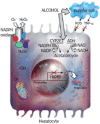Is the iron regulatory hormone hepcidin a risk factor for alcoholic liver disease?
- PMID: 19291818
- PMCID: PMC2658862
- DOI: 10.3748/wjg.15.1186
Is the iron regulatory hormone hepcidin a risk factor for alcoholic liver disease?
Abstract
Despite heavy consumption over a long period of time, only a small number of alcoholics develop alcoholic liver disease. This alludes to the possibility that other factors, besides alcohol, may be involved in the progression of the disease. Over the years, many such factors have indeed been identified, including iron. Despite being crucial for various important biological processes, iron can also be harmful due to its ability to catalyze Fenton chemistry. Alcohol and iron have been shown to interact synergistically to cause liver injury. Iron-mediated cell signaling has been reported to be involved in the pathogenesis of experimental alcoholic liver disease. Hepcidin is an iron-regulatory hormone synthesized by the liver, which plays a pivotal role in iron homeostasis. Both acute and chronic alcohol exposure suppress hepcidin expression in the liver. The sera of patients with alcoholic liver disease, particularly those exhibiting higher serum iron indices, have also been reported to display reduced prohepcidin levels. Alcohol-mediated oxidative stress is involved in the inhibition of hepcidin promoter activity and transcription in the liver. This in turn leads to an increase in intestinal iron transport and liver iron storage. Hepcidin is expressed primarily in hepatocytes. It is noteworthy that both hepatocytes and Kupffer cells are involved in the progression of alcoholic liver disease. However, the activation of Kupffer cells and TNF-alpha signaling has been reported not to be involved in the down-regulation of hepcidin expression by alcohol in the liver. Alcohol acts within the parenchymal cells of the liver to suppress the synthesis of hepcidin. Due to its crucial role in the regulation of body iron stores, hepcidin may act as a secondary risk factor in the progression of alcoholic liver disease. The clarification of the mechanisms by which alcohol disrupts iron homeostasis will allow for further understanding of the pathogenesis of alcoholic liver disease.
Figures


References
-
- De Domenico I, McVey Ward D, Kaplan J. Regulation of iron acquisition and storage: consequences for iron-linked disorders. Nat Rev Mol Cell Biol. 2008;9:72–81. - PubMed
-
- Aisen P, Enns C, Wessling-Resnick M. Chemistry and biology of eukaryotic iron metabolism. Int J Biochem Cell Biol. 2001;33:940–959. - PubMed
-
- Frazer DM, Anderson GJ. The orchestration of body iron intake: how and where do enterocytes receive their cues? Blood Cells Mol Dis. 2003;30:288–297. - PubMed
Publication types
MeSH terms
Substances
Grants and funding
LinkOut - more resources
Full Text Sources

